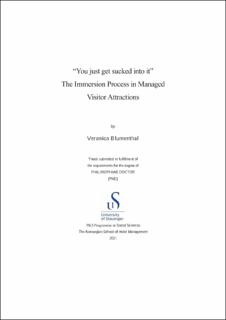| dc.contributor.advisor | Jensen, Øystein | |
| dc.contributor.advisor | Gjerald, Olga | |
| dc.contributor.author | Blumenthal, Veronica | |
| dc.date.accessioned | 2021-02-02T11:41:51Z | |
| dc.date.available | 2021-02-02T11:41:51Z | |
| dc.date.issued | 2021-02 | |
| dc.identifier.citation | “You just get sucked into it”: The Immersion Process in Managed Visitor Attractions by Veronica Blumenthal, Stavanger : University of Stavanger, 2021 (PhD thesis UiS, no. 572) | en_US |
| dc.identifier.isbn | 978-82-7644-986-0 | |
| dc.identifier.issn | 1890-1387 | |
| dc.identifier.uri | https://hdl.handle.net/11250/2725789 | |
| dc.description | PhD thesis in Hotel and tourism management | en_US |
| dc.description.abstract | The purpose of this thesis is to examine the nature of the immersion process, the process through which consumers become immersed, in the context of managed visitor attractions. This is a nascent research topic that has received limited attention from tourism scholars and this thesis is, therefore, explorative in nature, seeking to pursue the following overarching research aims:
Aim 1: Explore the underlying structures and mechanisms of the process leading to the state of immersion in the context of managed visitor attractions
Aim 2: Explore how context and contextual conditions might influence the immersion process These aims are explored through the three papers which constitute this thesis. Each paper presents an empirical case study based on the procedures of grounded theory (Strauss & Corbin, 1990) conducted in the context of experience products offered within managed visitor attractions. Each of the three case studies employed a qualitative approach to the data collection, utilizing a combination of semistructured in-depth interviews and observations. In line with the grounded theory logic, the findings generated in each study were expanded on and further developed through each consecutive case study, turning this thesis into a multiple-case study.
Through this multiple-case study, an empirically grounded, contextually bound model of the immersion process gradually emerged. The model demonstrates that, in the context of managed visitor attractions, the immersion process consists of three stages: involvement triggers, involvement worlds, and the state of immersion. Each stage was connected to increasingly higher levels of involvement (engagement, engrossment, and transcending involvement respectively) and visitors were found to fluctuate between them in a dynamic fashion. Combined, this can be described as the underlying structure of the immersion process. The structure appeared to be held together by four mechanisms, as the findings showed that the visitors played an important role as cocreators of stimuli, that involvement was a key force driving the immersion process forward, and that the visitors’ progression through the process was moderated by the visitors’ individual (cognitive, behavioral, and affective) responses, which were in turn influenced by several antecedent factors including experience design factors, social factors, personal factors, and the visitors’ appraisals.
These core characteristics of the immersion process (structure and mechanisms) were consistently identified across each of the three case studies. This does not, however, imply that contextual differences were irrelevant to the immersion process, instead, contextual conditions influenced which “involvement triggers” and “involvement worlds” the visitors could access, the type of individual responses that were recorded, and which antecedents influenced these responses.
The findings provide novel insights into the nature of the immersion process in the context of experience products offered within managed visitor attractions. Thus, contributing to expand the limited body of research that exists on the immersion process in tourism-related visitation contexts. | en_US |
| dc.language.iso | eng | en_US |
| dc.publisher | University of Stavanger, Norway | en_US |
| dc.relation.ispartofseries | PhD thesis UiS; | |
| dc.relation.ispartofseries | ;572 | |
| dc.relation.haspart | Paper 1: Blumenthal, V., & Jensen, Ø. (2019). Consumer immersion in the experiencescape of managed visitor attractions: The nature of the immersion process and the role of involvement. Tourism Management Perspectives, 30, 159 - 170. | en_US |
| dc.relation.haspart | Paper 2: Blumenthal, V. (2020). Consumer immersion in managed visitor attractions: The role of individual responses and antecedent factors. Scandinavian Journal of Hospitality and Tourism, 20(1), 4-27. | en_US |
| dc.relation.haspart | Paper 3: Blumenthal, V., & Gjerald, O. “You just get sucked into it”: Extending the Immersion process model to virtual experiences in managed visitor attractions. Submitted to Journal of Hospitality and Tourism Management. | en_US |
| dc.rights | Copyright the author, all right reserved | |
| dc.subject | reiselivsnæringen | en_US |
| dc.subject | turistnæringen | en_US |
| dc.subject | økonomi | en_US |
| dc.subject | reiseliv | en_US |
| dc.subject | turistattraksjoner | en_US |
| dc.title | “You just get sucked into it”: The Immersion Process in Managed Visitor Attractions | en_US |
| dc.type | Doctoral thesis | en_US |
| dc.rights.holder | ©2021 Veronica Blumenthal | en_US |
| dc.subject.nsi | VDP::Samfunnsvitenskap: 200::Økonomi: 210 | en_US |
